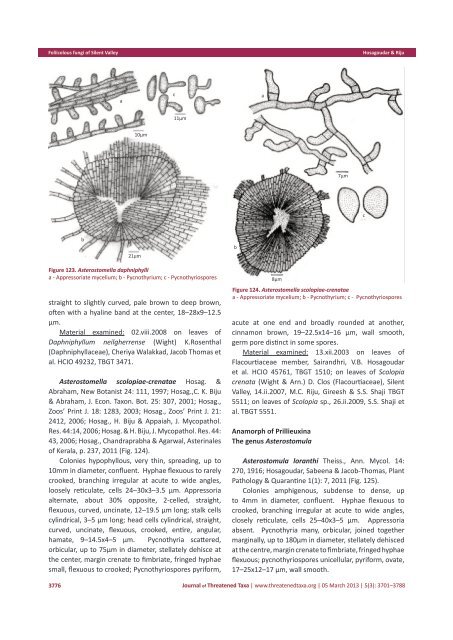Foliicolous fungi <strong>of</strong> Silent ValleyHosagoudar & Rijuaca11µm10µm7µmcb21µmbFigure 123. Asterostomella daphniphyllia - Appressoriate mycelium; b - Pycnothyrium; c - Pycnothyriosporesstraight to slightly curved, pale brown to deep brown,<strong>of</strong>ten with a hyaline band at the center, 18–28x9–12.5µm.Material examined: 02.viii.2008 on leaves <strong>of</strong>Daphniphyllum neilgherrense (Wight) K.Rosenthal(Daphniphyllaceae), Cheriya Walakkad, Jacob Thomas etal. HCIO 49232, TBGT 3471.Asterostomella scolopiae-crenatae Hosag. &Abraham, New Botanist 24: 111, 1997; Hosag.,C. K. Biju& Abraham, J. Econ. Taxon. Bot. 25: 307, 2001; Hosag.,Zoos’ Print J. 18: 1283, 2003; Hosag., Zoos’ Print J. 21:2412, 2006; Hosag., H. Biju & Appaiah, J. Mycopathol.Res. 44:14, 2006; Hosag. & H. Biju, J. Mycopathol. Res. 44:43, 2006; Hosag., Chandraprabha & Agarwal, Asterinales<strong>of</strong> Kerala, p. 237, 2011 (Fig. 124).Colonies hypophyllous, very thin, spreading, up to10mm in diameter, confluent. Hyphae flexuous to rarelycrooked, branching irregular at acute to wide angles,loosely reticulate, cells 24–30x3–3.5 μm. Appressoriaalternate, about 30% opposite, 2-celled, straight,flexuous, curved, uncinate, 12–19.5 μm long; stalk cellscylindrical, 3–5 μm long; head cells cylindrical, straight,curved, uncinate, flexuous, crooked, entire, angular,hamate, 9–14.5x4–5 μm. Pycnothyria scattered,orbicular, up to 75μm in diameter, stellately dehisce atthe center, margin crenate to fimbriate, fringed hyphaesmall, flexuous to crooked; Pycnothyriospores pyriform,8µmFigure 124. Asterostomella scolopiae-crenataea - Appressoriate mycelium; b - Pycnothyrium; c - Pycnothyriosporesacute at one end and broadly rounded at another,cinnamon brown, 19–22.5x14–16 μm, wall smooth,germ pore distinct in some spores.Material examined: 13.xii.2003 on leaves <strong>of</strong>Flacourtiaceae member, Sairandhri, V.B. Hosagoudaret al. HCIO 45761, TBGT 1510; on leaves <strong>of</strong> Scolopiacrenata (Wight & Arn.) D. Clos (Flacourtiaceae), SilentValley, 14.ii.2007, M.C. Riju, Gireesh & S.S. Shaji TBGT5511; on leaves <strong>of</strong> Scolopia sp., 26.ii.2009, S.S. Shaji etal. TBGT 5551.Anamorph <strong>of</strong> PrillieuxinaThe genus AsterostomulaAsterostomula loranthi Theiss., Ann. Mycol. 14:270, 1916; Hosagoudar, Sabeena & Jacob-Thomas, PlantPathology & Quarantine 1(1): 7, 2011 (Fig. 125).Colonies amphigenous, subdense to dense, upto 4mm in diameter, confluent. Hyphae flexuous tocrooked, branching irregular at acute to wide angles,closely reticulate, cells 25–40x3–5 µm. Appressoriaabsent. Pycnothyria many, orbicular, joined togethermarginally, up to 180µm in diameter, stellately dehiscedat the centre, margin crenate to fimbriate, fringed hyphaeflexuous; pycnothyriospores unicellular, pyriform, ovate,17–25x12–17 µm, wall smooth.3776<strong>Journal</strong> <strong>of</strong> <strong>Threatened</strong> <strong>Taxa</strong> | www.threatenedtaxa.org | 05 March 2013 | 5(3): 3701–3788
Foliicolous fungi <strong>of</strong> Silent ValleyHosagoudar & RijuPalghat, V.B. Hosagoudar et al. HCIO 47594, TBGT 2616;HCIO 47596, TBGT 2618; HCIO 47598 TBGT 2620REFERENCESab7µmc8µmFigure 125. Asterostomula loranthia - Mycelium; b - Pycnothyrium; c - Pycnothyriospores12µmMaterial examined: 26.ii.2009 on leaves <strong>of</strong> Loranthussp. (Loranthaceae), Sairandhri, S.S. Shaji et al. TBGT5555.Unidentified speciesLeptosphaerulina sp.: Materials examined: 27.iv.2007on leaves <strong>of</strong> Flamingia sp. (Papilonaceae), Silent ValleyNational Park, M. Harish et al. HCIO 49758, TBGT 3910.Meliolina sp.: Materials examined: 23.viii.2009 onleaves <strong>of</strong> Syzygium sp. (Myrtaceae), Silent Valley NationalPark, Kerala, Jayakumar et al. HCIO 50045 TBGT 4197.Phyllachora sp.: Materials examined:13.xii.2003 onleaves <strong>of</strong> Sterculia sp. (Sterculiaceae), Sairandhri, SilentValley, Palghat, V.B. Hosagoudar et al. TBGT 2688 HCIO47666.Phyllachora sp.: Materials examined: 12.xii.2003 onleaves <strong>of</strong> Scolopia sp. (Flacourtiaceae), Sairandhri, SilentValley, Palghat, V.B. Hosagoudar et al. HCIO 47670 TBGT2692.Phyllachora sp.: Materials examined: 14.xii.2003 onleaves <strong>of</strong> Fabaceae member, Chempathy, Silent Valley,Bhat, D.J. (2010). Fascinating micr<strong>of</strong>ungi (Hyphomycetes) <strong>of</strong> WesternGhats, India. Broadway Book Centre, Goa, 221pp.Chavan, P.B. & V.B. Hosagoudar (1984). Three new fungi from Satara,Maharashtra, India. <strong>Journal</strong> <strong>of</strong> Economic and Taxonomic Botany 5:447–450.Chavan, P.B. & V.B. Hosagoudar (1985). A preliminary survey <strong>of</strong> thefungi on monocot crops and weeds <strong>of</strong> Satara, Maharashtra, India.<strong>Journal</strong> <strong>of</strong> Economic and Taxonomic Botany 6: 239–243.Hansford, C.G. (1961). The Meliolineae. The Monograph. SydowiaBeih, 2: 1–806Hosagoudar, V.B. (1985). Miscellaneous fungi from south India. <strong>Journal</strong><strong>of</strong> Economic and Taxonomic Botany 7: 45–47.Hosagoudar, V.B. (1996). Meliolales <strong>of</strong> India. Botanical Survey <strong>of</strong> India,Calcutta, 363pp.Hosagoudar, V.B. (2006a). Additions to the fungi <strong>of</strong> Kerala. Zoos’ Print<strong>Journal</strong> 21(7): 2322–2330.Hosagoudar, V.B. (2006b). Additions to the fungi <strong>of</strong> Kerala–II. Zoos’Print <strong>Journal</strong> 21(9): 2412–2416.Hosagoudar, V.B. (2006c). Additions to the fungi <strong>of</strong> Kerala–IV. Zoos’Print <strong>Journal</strong> 21(11): 2475–2478.Hosagoudar, V.B. (2007). Additions to the fungi <strong>of</strong> Kerala–V. Zoos’ Print<strong>Journal</strong> 22(9): 2834–2836.Hosagoudar, V.B. (2008). Meliolales <strong>of</strong> India. Vol. II. Botanical Survey<strong>of</strong> India, Calcutta, 390pp.Hosagoudar, V.B. (2010). Anamorphs <strong>of</strong> Asterinales. <strong>Journal</strong> <strong>of</strong>Theretical and experimental Biology 6(3&4): 199–211Hosagoudar, V.B. & G.R. Archana (2009a). Studies on foliicolousfungi–XXVII. Indian <strong>Journal</strong> <strong>of</strong> Science and Technology 2(6): 1.Hosagoudar, V.B. & G.R. Archana (2009b). Meliolaceae <strong>of</strong> Kerala,India–XXVIII. <strong>Journal</strong> <strong>of</strong> <strong>Threatened</strong> <strong>Taxa</strong> 1(6): 348–350.Hosagoudar, V.B. & H. Biju (2005). Asteridiella pygei Hansf. var.microspora Hosag., a new record to southern India. Zoos’ Print<strong>Journal</strong> 20(6): 1898–1899.Hosagoudar, V.B. & H. Biju (2006). Studies on foliicolous fungi–XXII.Micr<strong>of</strong>ungi <strong>of</strong> Silent Valley National Park, Palghat District in KeralaState. <strong>Journal</strong> <strong>of</strong> Mycopathological Research 44: 39–48Hosagoudar, V.B. & A.C. Prabha (2009). New Asterinaceae membersfrom Kerala, India. Indian <strong>Journal</strong> <strong>of</strong> Science and Technology 2(6):15–16.Hosagoudar, V.B., M.C. Riju (2011a). Some interesting Meliolaceaemembers from Western Ghats Region <strong>of</strong> Kerala State. PlantPathology & Quarantine 1(2): 121–129.Hosagoudar, V.B. & M.C. Riju (2011b). Three new fungi from SilentValley National Park, Kerala, India. <strong>Journal</strong> <strong>Threatened</strong> <strong>Taxa</strong> 3(3):1615–1619.Hosagoudar, V.B., T.K. Abraham & P. Pushpangadan (1996). Fungi<strong>of</strong> Kerala. Tropical Botanic Garden and Research Institute, Palode,Thiruvananthapuram, 151pp.Hosagoudar, V.B., A.C. Prabha & D.K. Agarwal (2011). Asterinales <strong>of</strong>Kerala. Associated Publishing Company, 270pp+pl.23.Hosagoudar, V.B., J. Thomas, S.S Shaji & P.P.R. Kumar (2009). A newBalladyna species from Kerala, India. Indian <strong>Journal</strong> <strong>of</strong> Science andTechnology 2(6): 9.Hosagoudar, V.B., M.C. Riju & D.K. Agarwal (2010). Three newmeliolaceae members from Silent Valley National Park. IndianPhytopathology 63(1): 76–78.Hughes, S.J. (1993). Meliolina and Its Eexcluded Species. IMI Kew,England.Hughes, S.J. (1976). Sooty moulds. Mycologia 68: 693–820.Manilal, K.S. (1998). Flora <strong>of</strong> Silent Valley. The Mathrubhumi (MM)Press, Calicut, 398pp.Mohanan, C. (2003). Mycorrhizae in forest plantations: association,<strong>Journal</strong> <strong>of</strong> <strong>Threatened</strong> <strong>Taxa</strong> | www.threatenedtaxa.org | 05 March 2013 | 5(3): 3701–37883777

















